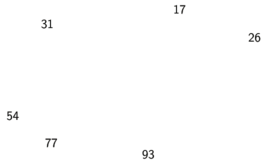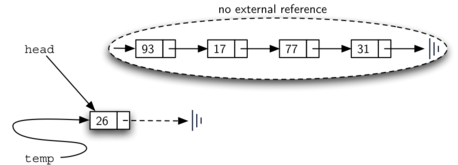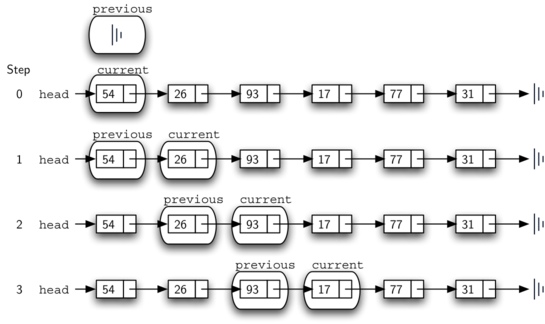Implementing an Unordered List
In order to implement an unordered list, we will construct what is commonly known as a linked list. Recall that we need to be sure that we can maintain the relative positioning of the items. However, there is no requirement that we maintain that positioning in contiguous memory. For example, consider the collection of items shown below. It appears that these values have been placed randomly.

If we can maintain some explicit information in each item, namely the location of the next item, then the relative position of each item can be expressed by simply following the link from one item to the next:

It is important to note that the location of the first item of the list must be explicitly specified. Once we know where the first item is, the first item can tell us where the second is, and so on. The external reference is often referred to as the head of the list. Similarly, the last item needs to know that there is no next item.
The Node Class
The basic building block for the linked list implementation is the node. Each node object must hold at least two pieces of information. First, the node must contain the list item itself. We will call this the data field of the node. In addition, each node must hold a reference to the next node. Here we provide one simple Python implementation:
class Node(object):
def __init__(self, value):
self.value = value
self.next = None
To construct a node, you need to supply the initial data value for the node. Evaluating the assignment statement below will yield a node object containing the value passed:
>>> temp = Node(93)
>>> temp.value
93
The special Python reference value None will play an important role in
the Node class and later in the linked list itself. A reference to
None will denote the fact that there is no next node. Note in the
constructor that a node is initially created with next set to None.
Since this is sometimes referred to as “grounding the node,” we will use
the standard ground symbol to denote a reference that is referring to
None. It is always a good idea to explicitly assign None to your
initial next reference values.

The Unordered List Class
As we suggested above, the unordered list will be built from a
collection of nodes, each linked to the next by explicit references. As
long as we know where to find the first node (containing the first
item), each item after that can be found by successively following the
next links. With this in mind, the UnorderedList class must maintain a
reference to the first node. Below we show the
constructor. Note that each list object will maintain a single reference
to the head of the list.
class UnorderedList(object):
def __init__(self):
self.head = None
Initially when we construct a list, there are no items. The assignment statement
>>> mylist = UnorderedList()
creates this linked list representation:

As we discussed in the Node
class, the special reference None will again be used to state that the
head of the list does not refer to anything. Eventually, the example
list given earlier will be represented by this linked list:

The head of the list refers to the first node which contains the first item of the list. In turn, that node holds a reference to the next node (the next item) and so on. It is important to note that the list class itself does not contain any node objects. Instead it contains a single reference to only the first node in the linked structure.
The is_empty method, shown below, simply
checks to see if the head of the list is a reference to None. The
result of the boolean expression self.head is None will only be true if
there are no nodes in the linked list. Since a new list is empty, the
constructor and the check for empty must be consistent with one another.
This shows the advantage to using the reference None to denote the
“end” of the linked structure. In Python, None can be compared to any
reference. Two references are equal if they both refer to the same
object. We will use this often in our remaining methods.
def is_empty(self):
return self.head is None
So, how do we get items into our list? We need to implement the add
method. However, before we can do that, we need to address the important
question of where in the linked list to place the new item. Since this
list is unordered, the specific location of the new item with respect to
the other items already in the list is not important. The new item can
go anywhere. With that in mind, it makes sense to place the new item in
the easiest location possible.
Recall that the linked list structure provides us with only one entry
point, the head of the list. All of the other nodes can only be reached
by accessing the first node and then following next links. This means
that the easiest place to add the new node is right at the head, or
beginning, of the list. In other words, we will make the new item the
first item of the list and the existing items will need to be linked to
this new first item so that they follow.
The linked list shown above was built by
calling the add method a number of times.
>>> mylist.add(31)
>>> mylist.add(77)
>>> mylist.add(17)
>>> mylist.add(93)
>>> mylist.add(26)
>>> mylist.add(54)
Note that since 31 is the first item added to the list, it will eventually be the last node on the linked list as every other item is added ahead of it. Also, since 54 is the last item added, it will become the data value in the first node of the linked list.
The add method is shown below. Each item of the list must reside in a node
object. We create a new node within the method and place the item as its
value. Then we complete the process by linking the new node into the existing
structure.
def add(self, item):
temp = Node(item)
temp.next = self.head
self.head = temp
This requires two steps as
shown below. Step 1 (line 3) changes the
next reference of the new node to refer to the old first node of the
list. Now that the rest of the list has been properly attached to the
new node, we can modify the head of the list to refer to the new node.

The order of the two steps described above is very important. What happens if the order of the steps is reversed? If the modification of the head of the list happens first, the result can be seen below. Since the head was the only external reference to the list nodes, all of the original nodes are lost and can no longer be accessed.

The next methods that we will implement–size, search, and
remove–are all based on a technique known as linked list
traversal. Traversal refers to the process of systematically visiting
each node. To do this we use an external reference that starts at the
first node in the list. As we visit each node, we move the reference to
the next node by “traversing” the next reference.
To implement the size method, we need to traverse the linked list and
keep a count of the number of nodes that occurred.
Below we provide the Python code for counting the
number of nodes in the list. The external reference is called current
and is initialized to the head of the list in line 2. At the start of
the process we have not seen any nodes so the count is set to . Lines
4–6 actually implement the traversal. As long as the current reference
has not seen the end of the list (None), we move current along to the
next node via the assignment statement in line 6. Every time current moves
to a new node, we add to count. Finally, count gets returned
after the iteration stops.
def size(self):
current = self.head
count = 0
while current is not None:
count = count + 1
current = current.next
return count
Searching for a value in a linked list implementation of an unordered list also uses the traversal technique. As we visit each node in the linked list we will ask whether the data stored there matches the item we are looking for. In this case, however, we may not have to traverse all the way to the end of the list. In fact, if we do get to the end of the list, that means that the item we are looking for must not be present. Also, if we do find the item, there is no need to continue.
Here is a possible implementation of search:
def search(self, item):
current = self.head
while current is not None:
if current.value == item:
return True
current = current.next
return False
The remove method requires two logical steps. First, we need to
traverse the list looking for the item we want to remove. Once we find
the item (recall that we assume it is present), we must remove it. The
first step is very similar to search. Starting with an external
reference set to the head of the list, we traverse the links until we
discover the item we are looking for. Since we assume that item is
present, we know that the iteration will stop before current gets to
None.
Once we have found the node to be removed, how do we remove it? One possibility would be to replace the value of the item with some marker that suggests that the item is no longer present. The problem with this approach is the number of nodes will no longer match the number of items. It would be much better to remove the item by removing the entire node.
In order to remove the node containing the item, we need to modify the
link in the previous node so that it refers to the node that comes after
current. Unfortunately, there is no way to go backward in the linked
list. Since current refers to the node ahead of the node where we
would like to make the change, it is too late to make the necessary
modification.
The solution to this dilemma is to use two external references as we
traverse down the linked list. current will behave just as it did
before, marking the current location of the traverse. The new reference,
which we will call previous, will always travel one node behind
current. That way, when current stops at the node to be removed,
previous will be referring to the proper place in the linked list for
the modification.
Here is an implementation of a complete remove method:
def remove(self, item):
current = self.head
previous = None
while True:
if current.value == item:
break
previous, current = current, current.next
if previous is None:
self.head = current.next
else:
previous.next = current.next
First we assign current and previous to the head of the list and None
respectively. Then, on each iteration of our while loop, we break if current
represents the node we wish to remove, and if not we update previous and
current to current and current.next respectively. Again, the order of
these two statements is crucial. previous must first be moved one node ahead
to the location of current. At that point, current can be moved.
Here we illustrate the movement of previous and current as they progress
down the list looking for the node containing the value 17:

Once the searching step of the remove has been completed, we need to remove
the node from the linked list. If previous is None, we know that current
is in fact the head of the list, so we remove that node by updating the head
of the list to the subsequent node, thereby losing the reference to the
original head node:

In all other cases, we know that both previous and current are nodes in
the list, so we can remove current by setting the next attribute of
previous to the node after current in the list:

The remaining methods append, insert, index, and pop are left as
exercises. Remember that each of these must take into account whether
the change is taking place at the head of the list or someplace else.
Also, insert, index, and pop require that we name the positions of
the list. We will assume that position names are integers starting with
0.